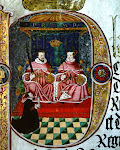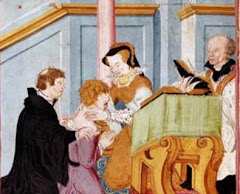
Funeral effigy of Mary I
On this day in 1558 Queen Mary I died at St James's Palace. She was 42 years old and had reigned for little over five years.
Details of the deathbed scene were provided by John Foxe in the second edition (1570) of the famous Actes and Monuments ('Book of Martyrs'). The 'great afflications fallyung vppon this Realme' under Mary, 'wherin so many mē, women, and children were burned, many imprisoned and in prisons starued, diuers exiled, some spoyled of goods and possessions, a great number driuen from house and home, so many weepyng eyes, so many sobbyng hartes, so many childrē made fatherles, so many fathers bereft of their wiues and children so many vexed in conscience' (you get the drift), came to an abrupt end in the winter of 1558,
'...after all this (I say) now we are come at length (the Lord be praysed) to the xvij. day of Nouember, day as it brought to the persecuted members of Christ, rest from their carefull mourning, so it easeth me somwhat likewise of my laborious writyng, by the death I meane of Queene Mary. Who beyng long sicke before, vpō the sayd xvij. day of Nouember, in the yeare aboue sayd, about iij. or iiij. a clocke in the mornyng, yelded her life to nature, and her kyngdome to Queene Elizabeth her sister.'
[Foxe, Actes and Monuments, 1570 edn., Book 12, p. 2336].
Foxe recorded that 'some said that she dyed of a Tympany', a diagnosis that has proved enduring though seems to have lost favor in recent years. But he also speculated whether 'by her much sighing before her death, supposed she dyed of thought and sorow.'
What of the famous tale that the dying queen declared that when she was gone, and her body opened, the word 'Calais' would be found engraved upon her heart? Here too Foxe comes to the rescue; the story is first mentioned in the second edition of Actes and Monuments. Though it is a highly improbable claim it nonetheless perfectly sums up popular perceptions of Mary and her reign. For subsequent centuries Mary has been regarded as an incompetent ruler - one of England's worst - best remembered for her spectacular failings in government, the church and in war. The loss of Calais, England's last remaining territory in France, in early 1558 has frequently been selected as a good example of how utterly disastrous her reign was. So why not incorporate it somehow into her deathbed speech? Especially as such a loss was for many of Mary's opponents, not least Foxe, explicit evidence of divine disapproval of this queen and her religious policies.
'Wherupon her Counsell seyng her sighing, and desirous to know the cause, to the end they might minister the more ready cōsolation vnto her, feared, as they sayd, that she tooke that thought for the kynges Maiestie her husband, which was gone from her. To whom she aunswering againe: In deede (sayd she) that may be one cause, but that is not the greatest woūd that pearceth my oppressed minde: but what that was she would not expresse to them. Albeit, afterward she opened the matter more playnely to M. Rise and Mistres Clarentius (if it be true that they told me, which heard it of M. Ryse him selfe) who then beyng most familiar with her, and most bolde about her, tolde her that they feared she tooke thought for king Philips departing frō her. Not that onely (sayd she) but when I am dead & opened, you shall find Calyce lying in my hart....'
[Foxe, Actes and Monuments, 1570 edn., Book 12, p. 2336-7].
Foxe and co had another cause of celebration. Christmas came early for the Protestants as Archbishop Reginald Pole died that same day. In a matter of hours England lost its last Catholic monarch who governed an England united with Rome (unlike James II) and its last Catholic archbishop of Canterbury. It would be complete wrong of me not to make some mention of the death of one of the most brilliant, albeit controversial and divisive, churchmen of the sixteenth-century, if not the early modern period.

Reginald Pole by unknown artist, c.1550? Lambeth Palace, London.
Like Mary, Pole had been suffering ill health since the late summer of 1558. Though Foxe claims Mary died sometime between 3-4am, we know from Alvise Priuli, Pole's close confidante who was with him to the end, that she 'died at 7 after midnight on 17th' [around 7am]. So she passed away before Pole who died at 7pm. News of the queen's death reached him though initially his attendants thought it best to keep the news secret lest it quicken his demise. As Priuli wrote to his brother on 27 November, someone went 'against this order' and all was revealed.[1] Naturally Pole was 'very worried about results of her death', but was nonetheless preoccupied with his own impending end.[2] With the support of attendants, Pole left his bed and bowed his head almost to the floor where he engaged in prayers.[3] He died a few hours later.
Three days before he died Pole wrote to Princess Elizabeth declaring that he thought it best 'to leave all persons satisfied of me especially you, thanks to God's providence' before making a futile plea for his chaplain to converse privately with her on religious matters.[4] For Elizabeth, the deaths of the Catholic sister and archbishop of Canterbury in rapid succession was a godsend. When the coup to place Jane Grey on the throne failed in July 1553 Mary was quick to declare God's hand in her succession. Like her namesake she was favored; God had established her on the throne so she may oversee the restoration of true religion. It was now Elizabeth's, and the Protestants', time to rejoice in the mercy of the Lord. Thus the new young queen when informed of her succession is supposed to have declared 'A Dominum factum est illud, et est mirabile in oculis nostris'. It is this the lord's doing and it is marvelous in our eyes.
~~~~~~~~~~~~~~~~~~~~~
2008 marked the 450th anniversaries of the deaths of Mary and Pole. Mary's demise went largely unmarked; Pole's ecclesiastical position appears to have secured him some recognition. For an example of this see the Requiem Mass 'offered for the repose of the soul of Reginald Cardinal Pole' held in the chapel of Magdalen College, Oxford (Pole's own college), in 2008:
http://www.flickr.com/photos/paullew/sets/72157609310417557/with/3038728057/
[1] Priuli's letter to his brother Antonio, 27 November 1558. Thomas F. Mayer (ed.), The Correspondence of Reginald Pole: Volume 3. A Calendar, 1555-1558: Restoring the English Church (Aldershot: Ashgate, 2004).
[2] Ibid.
[3] Priuli's letter to the archbishop of Toledo, aft. 15 December 1558. Ibid, pp. 588-90.
[4] Pole's letter to Princess Elizabeth, written from Lambeth, 14 November 1558. Ibid, p. 579.



